Diffusion: Applications
Diffusion: Applications
Oral
Oral
Diffusion
Wednesday, 15 May 2019
| Room 520A-F | 15:45 - 17:45 | Moderators: Nikolaus Weiskopf, Hui Zhang |
| 15:45 |
0995. 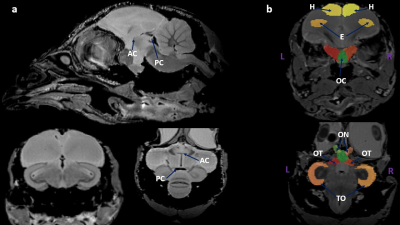 |
A novel 11.7T ultra-high field dMRI connectivity atlas of the Japanese quail
Raïssa Yebga Hot, Marine Siwiaszczyk, Justine Beaujoin, David Barrière, Ivy Uszynski, Scott Love, Ludovic Calandreau, Baptiste Mulot, Elodie Chaillou, Cyril Poupon
Despite the existence of several structural atlases of avian brains, few of them address the bird structural connectivity. In this study, a novel atlas of the structural connectivity is proposed for the Japanese quail, aiming at investigating two lines: the short and the long tonic immobility lines. Using high resolution T2-weighted MRI and ultra-high field diffusion MRI, the connectivity of both lines was investigated, showing the existence of structural differences between the connectivity patterns characterizing the two lines. Thus, the link between their specific behaviors facing fear and their underlying anatomical substrates reached a better understanding.
|
| 15:57 |
0996. 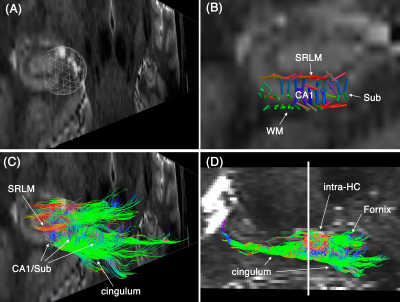 |
In-vivo diffusion imaging of hippocampal network with 600 µm isotropic resolution at 7T
Farshid Sepehrband, Ryan Cabeen, Jin Jin, Justin Haldar, Arthur Toga
Neuroimaging findings indicate that neurological disorders differentially target distinct subregions of the hippocampal circuit 1. Therefore, the ability to image hippocampal network is essential to study the mechanism of the disease pathophysiology. Here we propose a novel framework that enables high-resolution intra-hippocampal macro-structural and network diffusion imaging.
|
16:09 |
0997. 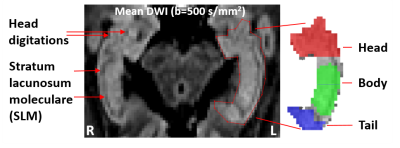 |
High Resolution Diffusion MRI of the Hippocampus Reveals Heterogenous Development across the Head, Body, and Tail Through Childhood and Adolescence
Kevin Solar, Sarah Treit, Emily Stolz, Christian Beaulieu
High resolution diffusion tensor imaging reveals regional-specificity in microstructural development of the healthy human hippocampus over 6-20 years. The whole structure, head, body, and tail were visualized and segmented directly on mean diffusion-weighted images. Whole-structure analyses showed age-related higher FA and lower MD, and substructure analysis revealed that these associations were strongest in the head – a finding corroborated by prior shape analyses showing greater expansion in the hippocampal head during development. This regional-specificity may reflect hippocampal neurogenesis and myelination in coherence with the high concentration of connections that form at the head from childhood into adulthood.
|
| 16:21 |
0998 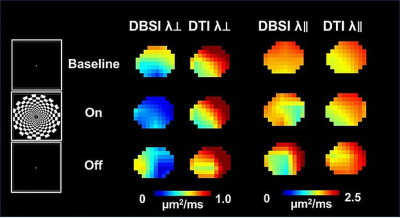 |
Assessing Human Optic Nerve Function using Diffusion Basis Spectrum Imaging (DBSI) Video Permission Withheld
Tsen-Hsuan (Abby) Lin, Peng Sun, William Spees, Ajit George, Hsin-Chieh Yang, Michael Wallendorf, Anne Cross, Junqian Xu, Sheng-Kwei Song
Previously, we employed diffusion fMRI to assess mouse optic nerve activation in response to flashing-light visual stimulation. Perpendicular apparent diffusion coefficient (ADC⊥) decreased independent of vascular effects. In the current study, we applied DTI and diffusion basis spectrum imaginig (DBSI) to assess human optic nerve activation with flashing checkerboard stimulation. We observed 43% and 13% decrease of DBSI λ⊥ and λ?, respectively, but not in DTI.
|
| 16:33 |
0999. 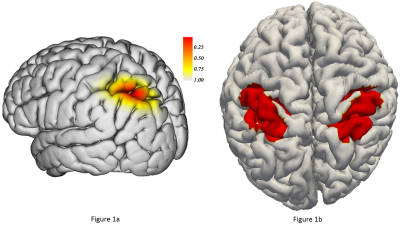 |
Joint evidences for a posterior parieto-motor cortex pathway in humans using diffusion MRI tractography and direct cortical stimulation
Achille Teillac, Pierre-Aurélien Beuriat, Nathalie Richard, Alexandru Szathmari, Carmine Mottolose, Michel Desmurget, Angela Sirigu, Bassem Hiba
This study aims to identify projections from the posterior parietal "reach area" to the primary motor cortex, in healthy humans, using diffusion MRI tractography and direct cortical stimulation information. We analyzed multiple-shell data from 20 subjects of the Human Connectome Project and found significant ipsilateral projections connecting the identified region to the primary motor cortex, especially the hand-knob area which shows the highest streamlines density on both hemispheres. Strikingly, we also identified a density peak in the left (language-related) hemisphere, within the dorsolateral part of the precentral gyrus related to mouth control.
|
16:45 |
1000. 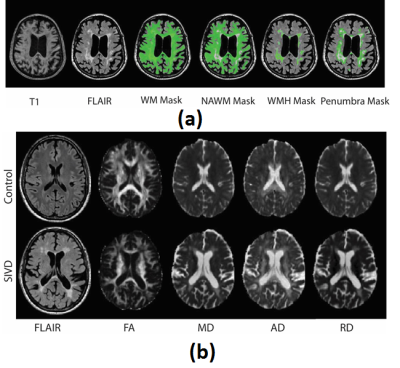 |
A Multiparametric DTI analysis for Stratification of CSVD Subgroups
Rajikha Raja, Jeffrey Thompson, Jill Prestopnik, Erik Erhardt, John Adair, Vince Calhoun, Gary Rosenberg, Arvind Caprihan
Vascular cognitive impairment and dementia (VCID) which includes all forms of small vessel diseases is associated with white matter (WM) damages. Diffusion tensor imaging (DTI) has been used widely in several studies in characterizing these WM changes in VCID. The aim of this study is to evaluate the classification accuracy of diffusion measures to distinguish cerebral small vessel disease (CSVD) subjects from healthy controls (HC) and be further able to discriminate CSVD subgroups consisting of subcortical ischemic vascular disease , mixed dementia , leukoaraiosis , and Alzheimer’s disease. The proposed classification framework includes feature extraction followed by multiclass random forest classification with leave one out cross validation. The classification features were defined based on histogram measures calculated on 4 WM regions from four DTI modalities (FA, MD, AD, and RD). Multiple classification tasks were performed owing to the different subject groups. We have shown that DTI combined with FLAIR and cognitive score can give up to 78% classification accuracy for the 5-group and the 4-group classification without the need of the harder to measure cerebrospinal fluid biomarkers.
|
| 16:57 |
1001. 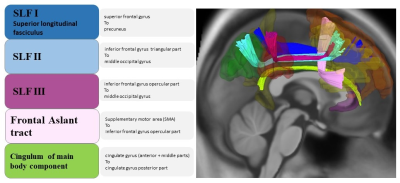 |
Fluid intelligence is associated with gray matter volume and white matter tract integrity within multiple-demand network across adult lifespan
PIN-YU CHEN, Chang-Le Chen, Yung-Chin Hsu, Tao-Han Hung, Cam CAN, Ming-Jang Chiu, Wen-Yih Tseng
In human brain, there are many cognitive demands sharing similar brain regions including working memory, attention, mathematical calculation and reasoning, and problem solving. These multiple-demand (MD) brain regions mainly involve the frontal and parietal lobes including the posterior-lateral frontal, dorso-medial frontal, and mid-parietal cortices. Previous studies with limited age ranges of the participant population reported the total brain volume was highly correlated with Gf and inconsistent findings of white matter tracts related with Gf. Fewer research explores the life-span patterns of Gf with gray and white matter and no previous study investigated the relationship of left and right hemispheres with Gf. The present study aimed to probe the life-span relationship between gray matter volume and white matter tracts connecting the MD regions and Gf in an adult life span large cohort of 603 normal participants from 18 to 88 years old. We also further compared the contributions of the left and right hemispheres to Gf. We hypothesized that gray matter volume and white matter tracts connecting the MD network may reflect age-related changes of Gf, and that Gf is a lateralized complex function. The novelty of our findings is that we examined larger normal adult population across 18 to 88 years old and found that both gray matter volume and white matter tract integrity in the MD regions are the neural substrates of Gf, reflecting the life-span aging patterns of Gf. We further examined the relationship of left and right hemispheres with Gf and found that left and right MD regions showed similar patterns of correlations with Gf scores. The age-related decrease of gray matter volume and tract integrity in the MD network is associated with the reduced functions of multiple-demand cognitive abilities reflected by Gf scores.
|
17:09 |
1002. 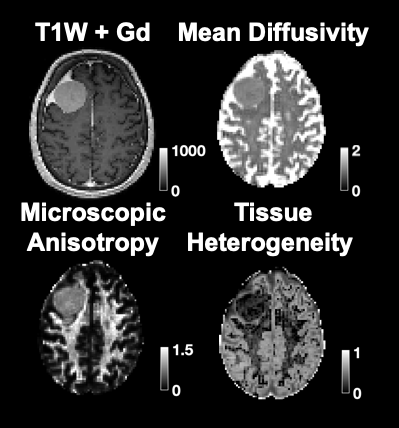 |
B-tensor encoding in meningiomas: Comparisons with histology, microimaging and tumor consistency
Jan Brabec, Filip Szczepankiewicz, Elisabeth Englund, Johan Bengzon, Linda Knutsson, Carl-Fredrik Westin, Pia C Sundgren, Markus Nilsson
B-tensor encoding enables a mapping of novel dMRI parameters such as microscopic anisotropy and tissue heterogeneity which are sensitive to elongated cell structures and heterogeneity in cell density, respectively. We applied b-tensor encoding to patients with meningioma tumors and compared the imaging findings to the histological type and grade as well as to the tumor consistency determined during surgery. Results show that microcystic/angiomatous meningiomas could be differentiated, and tumor consistency linked both to tissue heterogeneity and microscopic anisotropy and that tumor heterogeneity could provide additional contrast.
|
| 17:21 |
1003  |
Whole lesion IVIM analysis in the diagnosis of thyroid tumor: Comparison with Conventional Diffusion-Weighted Imaging Video Permission Withheld
Yunlong Yue, Minghui Song, Yanfang Jin, Jinsong Guo, Lili Zuo, Queenie Chan, Zhenchang Wang
To compare the diagnostic efficiency of IVIM parameters and conventional DWI (b=600 and b=990) derived from 3D whole-lesion (W-L ROI) delineation. Forty-three patients with 46 pathologically confirmed thyroid nodules were involved. According to ROC curve, D, f, ADC600 and ADC990 values showed diagnostic significance with the AUC values of 0.962, 0.756, 0.970 and 0.939 respectively. Furthermore, the Youden index of D value (0.871) was higher than that of ADC600 (0.826). IVIM is a more promising tool in the differentiation of benign and malignant thyroid nodules using W-L ROI delineation than conventional DWI.
|
| 17:33 |
1004. 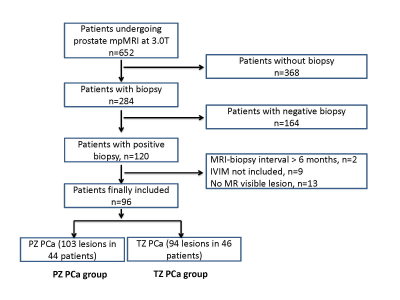 |
The performance of intravoxel-incoherent motion diffusion-weighted imaging (IVIM) derived hypoxia for the risk stratification of prostate cancer
Qiong Ye, Zhao Zhang
Prostate cancer (PCa) is one of the most common malignant cancers in man. A recently work derived the information of hypoxia from intravoxel-incoherent motion diffusion-weighted imaging (IVIM) and demonstrated strong correlation between IVIM derived hypoxia and immunohistological hypoxia marker. In our work, IVIM derived hypoxia demonstrated better discrimination ability for the risk of PCa than apparent diffusion coefficient (ADC) and pure tissue diffusion (Ds). It might further improve the risk stratification of PCa and can be used as a prognostic factor.
|
 Back to Program-at-a-Glance |
Back to Program-at-a-Glance |  Back to Top
Back to Top